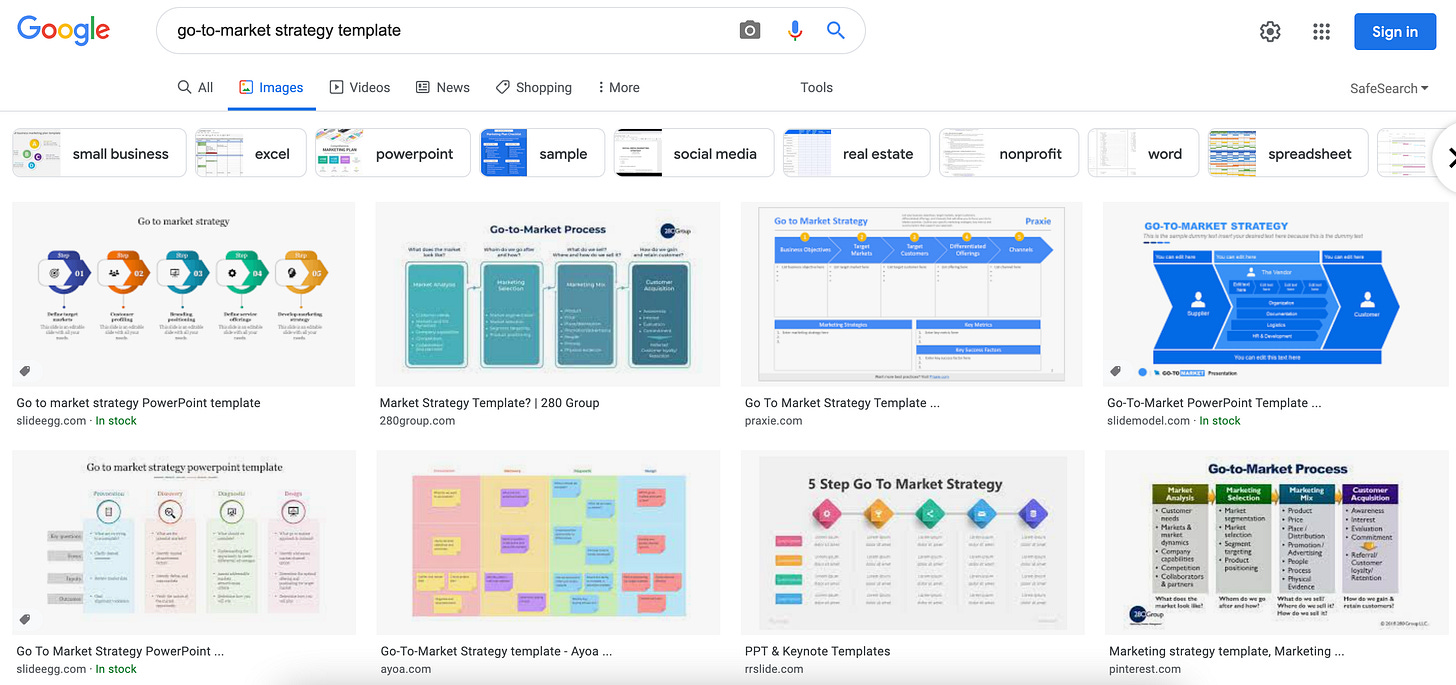My Simple Go-To-Market Strategy Template
For startup founders with no marketing experience

You've built a fantastic product, but no one seems to pay attention.
You’ve met investors, but they won’t commit until you can show some traction.
Without funding, you can’t hire your first marketer just yet.
The problem? You hate marketing — always have, always will.
But you need to figure out how and where to distribute your product.
The issue with most templates you’ll find online
You open your laptop and start searching for go-to-market strategy templates.
That’s what you find:
Unconvinced, you open the three first results and decide to give it a try.
GTM, TAM, SAM, SOM, ICP, TOFU, MOFU, BOFU, CAC, WOM, SEO, PPC, KPI…
“Is there a Duolingo for marketing terms?” you wonder.
After ten long minutes (that felt like days), you give up.
You convince yourself that “if you build it, they will come” and open Figma.
Look, I get it. Most templates that you’ll find online aren’t made for you.
They’re made for marketers at later stage companies who need to convince executives (therefore the excessive complexity and jargon).
They’re made for search engines so these websites can rank on Google and attract visitors (therefore the lengthy and repetitive content).
They’re made for lead generation so that these companies can capture potential customers (therefore the annoying email pop-ups and magnets).
What’s a good go-to-market strategy?
There’s no such thing as a “good go-to-market strategy.”
Every company is unique, making it impossible to have a one-size-fits-all blueprint. Instead, a good go-to-market strategy is the one that best fits with your company resources and will help you to achieve the goals you want to achieve.
Articulating your go-to-market strategy will help you:
To create clarity: establishing the context of your market (reason for being of your business, the alternatives, your customers, and their needs…).
To focus: narrowing down the opportunities and removing distractions.
Put your plan in motion: by turning your strategy into actionable initiatives.
When I work with founders that aren’t fond of marketing, I usually send them this podcast, in which Daniel Ek talks about how he approaches new problems:
“My mental image is that of a city when I approach a problem. And a city from 40,000 feet above on an airplane looking down. And when you do that, you don’t see the contours, you just see a city. You have no idea what aspects of the city, like what’s the topography, you don’t understand where it’s dense, where it’s not dense, it just looks like a blob. And so the important part for me is I don’t know what I don’t know. So I always start by allocating enough time. So if something is important, I start allocating time towards it. And then I quickly try to spend enough time where I can get to what I call level two, which is when I’m more like 20,000 feet perspective, where I can start seeing the contours of the city. I can kind of work out that here are the rough branches of the tree, so to speak. I can see the leaves. I can see the details. I can see all of those things, but I kind of have an idea of blocks to start diving into.”
A good strategy is a journey from seeing a blurry blob to seeing crisp blocks.
So why another template?
Throughout my years as a consultant, I've compiled a list of questions that can be used to develop a go-to-market plan that resonated with many founders.
These questions are derived or inspired from books I've read, newsletters I've subscribed to, and workshops I've held. Because the content is dispersed over multiple documents, sharing it usually requires a list of links and screenshots, which is inconvenient. I wanted to make the format more cohesive and accessible.
I’m realistic; I know that this template won't turn you into an enthusiast if you don't enjoy marketing in the first place. But I genuinely hope it can make the process more bearable for you. If you're into marketing, you'll probably stick to the more advanced alternatives, but it might be handy for someone you know.
So without further ado, here’s the template.
A go-to-market example: Substack
The template is a simple Notion doc that you can duplicate and customize.
I estimate that it will take you between 10 and 20 minutes to complete.
I tried to keep it as self-explanatory as possible. For inspiration, I also created an example describing how Substack brought their product to market (based on my own interpretation of origin stories that their team shared).
Best books on go-to-market strategy
If you want to dive further into this topic, here’s a list of books I can recommend.
Competing Against Luck by Clayton Christensen
Crossing the Chasm by Geoffrey Moore
Good Strategy Bad Strategy by Richard Rumelt
Hooked by Nir Eyal
Influence by Robert Cialdini
Obviously Awesome by April Dunford
The Cold Start Problem by Andrew Chen
Thinking in Bets by Annie Duke
This is Marketing by Seth Godin
I hope it helps. Best of luck to you and your startup on the road to market!




